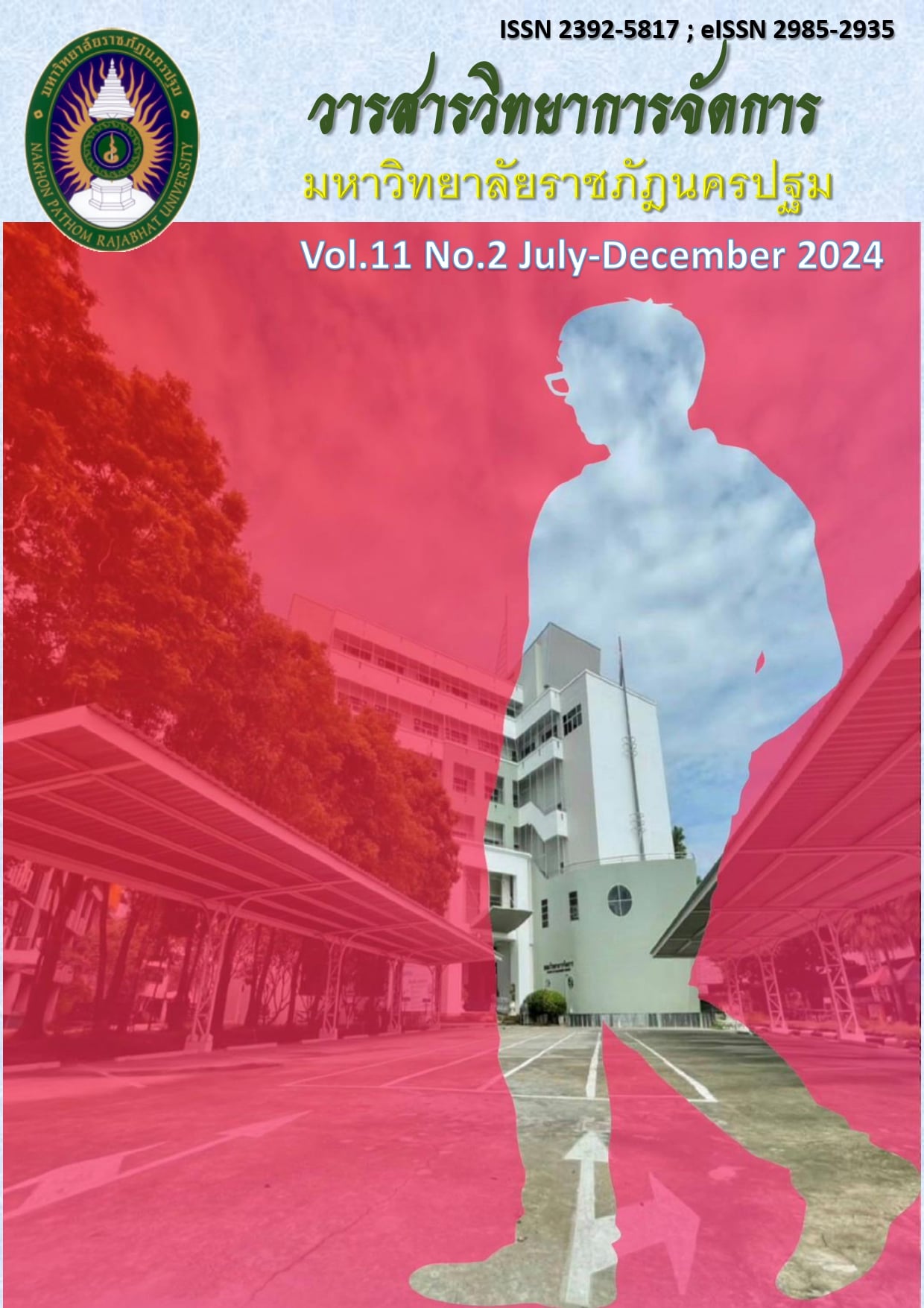Study of cultural tourism potential of temples in Nong Tak Ya Subdistrict, Tha Muang District, Kanchanaburi Province
Main Article Content
Abstract
This research article studies the cultural tourism potential of temples in Nong Tak Ya Subdistrict, Tha Muang District, Kanchanaburi Province. The objective is to 1) study the tourism potential of temples according to the criteria for considering the potential of tourist attractions and 2) study tourists' opinions on the cultural tourism potential of temples in Nong Tak Ya Subdistrict, Tha Muang District, Kanchanaburi Province, according to the components of cultural tourism. This research used a mixed-methods approach: The qualitative methods, interviews were conducted with local stakeholders, 3 peoples per temple including: the abbot or monk, community leaders, and people around the temple. The structured interviews were conducted and data were analyzed using content analysis, and the quantitative method uses a questionnaire, with a reliability of .873, data were collected from 384 tourists visiting temples in Nong Tak Ya Subdistrict, Tha Muang District, Kanchanaburi Province, by accidental sampling. Data were analyzed by frequency, percentage, mean and standard deviation.
The results were as follows:
1. Analysis of tourism potential of temples in Nong Tak Ya Subdistrict, Tha Muang District, Kanchanaburi Province according to the criteria for considering the potential of 5 tourist attractions or 5As from 13 temples, it was found that only 4 temples have the potential according to the criteria. Including Wat Nong Song Hong Phasukaram, a temple that is ready to accommodate tourists and has tourism potential in terms of attractions, tourist activities, accessibility, various facilities, and accommodation. Bhavanabaram Meditation Center has potential to be developed into a tourist attraction. There is architecture of beliefs that is a tourist attraction. There are various facilities such as buildings, restrooms, and tourist activities such as visiting, taking pictures, and admiring the beauty of the architecture. Wat Nong Tak Ya Aphaiyasad, a temple that is ready in every aspect, whether it is tourist activities for tourists, convenience in traveling, facilities, and souvenirs such as steamed dumplings that can be made into regular products of the tourist attraction, and Wat Nong Takrong has a tourist attraction, which is a white church that tourists passing by must get off to take pictures. There are facilities such as bathrooms and sufficient parking spaces, but there are no other activities to support tourists besides the activities of buddhist adornment.
2. Tourist opinions on the cultural tourism potential of temples in Nong Tak Ya Subdistrict, Tha Muang District, Kanchanaburi Province from the components of cultural tourism was found at a high level overall, when considering each aspect was found that tourism, tourism business, and community participation had the highest opinions, as for tourist awareness, environmental awareness, and marketing, opinions were at a high level.
Article history: Received 26 September 2024
Revised 16 December 2024
Accepted 17 December 2024
SIMILARITY INDEX = 14.09 %
Article Details

This work is licensed under a Creative Commons Attribution-NonCommercial-NoDerivatives 4.0 International License.
The views and opinions of the article appearing in this journal are those of the author. It is not considered a view and responsibility of the editorial staff.
References
กรมการท่องเที่ยว กระทรวงการท่องเที่ยวและกีฬา. (2557). คู่มือการตรวจประเมินมาตรฐานคุณภาพแหล่ง
ท่องเที่ยวทางวัฒนธรรม. (พิมพ์ครั้งที่ 2). กรุงเทพฯ: สำนักงานกิจการโรงพิมพ์องค์การ
สงเคราะห์ทหารผ่านศึกในพระบรมราชูปถัมภ์.
กระทรวงการท่องเที่ยวและกีฬา (2567). สถานการณ์การท่องเที่ยวในประเทศ รายจังหวัด ปี 2566.
[ออนไลน์] ค้นเมื่อ 25 มีนาคม 2567, จาก ttps://www.mots.go.th/news/category/705.
นุชประวีร์ ลิขิตศรัณย์ (2562). ศักยภาพแหล่งท่องเที่ยวของจังหวัดพิจิตร. วารสารการบริการและการ
ท่องเที่ยวไทย. 14 (1). 28-41.
นพวรรณ วิเศษสินธุ์ นงเยาว์ อุทุมพร ชูชาติ พ่วงสมจิตร์ และธีรพงษ์ บุญรักษา. (2560). ศักยภาพในการเป็น
แหล่งท่องเที่ยวเชิงพุทธของวัดในจังหวัดปทุมธานี. วารสารบัณฑิตศึกษา. 11 (3). 97-109.
กรุงเทพมหานคร: มหาวิทยาลัยราชภัฏวไลยอลงกรณ์ในพระบรมราชูปถัมภ์.
พระครูสมุทรวีราภรณ์ มหานาค. (2552). การพัฒนาการศักยภาพการท่องเที่ยวเชิงวัฒนะรรมของอำเภอ
พระสมุทรเจดีย์ จังหวัดสมุทรปราการ โดยการมีส่วนร่วมของชุมชน. วิทยานิพนธ์ศิลปศาสตร
มหาบัณฑิต สาขาวิชาวัฒนธรรมศาสตร์ มหาวิทยาลัยมหาสารคราม.
เพียงกานต์ นามวงศ์. (2552). การศึกษาแนวทางการพัฒนาการท่องเที่ยวเชิงวัฒนธรรมชุมชนไหล่หิน
อําเภอเกาะคา จังหวัดลําปาง. วิทยานิพนธ์ศิลปศาสตรมหาบัณฑิต สาขาวิชาการจัดการนันทนาการ
และการท่องเที่ยว สํานักงานบัณฑิตศึกษา มหาวิทยาลัยแม่โจ้.
ราณี อิสิชัยกุล. (2554). ความรู้เบื้องต้นเกี่ยวกับทรัพยากรการท่องเที่ยว. สาขาวิทยาการจัดการ มหาวิทยาลัย
สุโขทัยธรรมธิราช. นนทบุรี: มหาวิทยาลัยสุโขทัยธรรมาธิราช.
วนัสนันทน์ โพธิ์เพชร. (2563). ปัจจัยที่มีอิทธิพลต่อการตัดสินใจท่องเที่ยวแหล่งท่องเที่ยวเชิงประวัติศาสตร์
ของผู้เยี่ยมเยือนชาวไทย กรณีศึกษา อุทยานประวัติศาสตร์พระนครศรีอยุธยา. ปริญญาศิลปศาสตร
มหาบัณฑิต สาขาวิชาการจัดการอุตสาหกรรมการบริการและการท่องเที่ยว. บัณฑิตวิทยาลัย
มหาวิทยาลัยกรุงเทพ.
วิจิตรา บุญแล เสรี วงษ์มณฑา ชวลีย์ ณ ถลาง และกาญจน์นภา พงศ์พนรัตน์. (2564). การศึกษาศักยภาพ
องค์ประกอบของทรัพยากรการท่องเที่ยวเชิงวัฒนธรรมของจังหวัดจันทบุรี. วารสารสมาคมนักวิจัย.
(1) .46-55.
Buhalis, D. (2000). Marketing the competitive destination in the future. Tourism Management.
(1) . 97-116. http://dx.doi.org/10.1016/S0261-5177(99)00095-3
Pelasol, J. (2012). Igcabugao: A Potential Tourist Destination in the Southern Part of Iloilo,
Philippines. International. JPAIR Multidisciplinary Research is being certified for
QMS ISO 9001:2008 by the Anglo Japanese American Registrars of the United
Kingdom. 8, 90-97.

